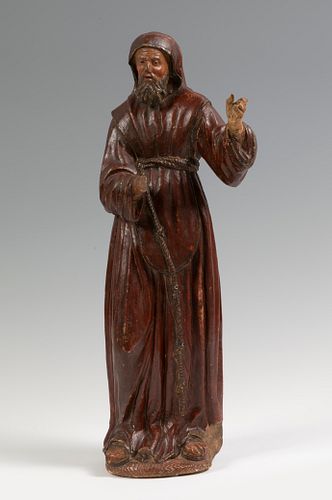Spanish school of the XVI-XVII centuries. Alabaster hand carved and polychrome.
Lot 28
About Seller
Setdart Auction House
Carrer Aragó 346
Barcelona
Spain
Setdart Subastas was born in 2004 and is currently the first online art auction in Spain with solidity, prestige and reliability guaranteed by our more than 60,000 users. Setdart has a young, dynamic and enterprising team ready to successfully manage the purchase and sale of art works through custom...Read more
Categories
Estimate:
EUR€2,000 - EUR€2,200
$2,083.33 - $2,291.67
Absentee vs Live bid
Two ways to bid:
- Leave a max absentee bid and the platform will bid on your behalf up to your maximum bid during the live auction.
- Bid live during the auction and your bids will be submitted real-time to the auctioneer.
Bid Increments
| Price | Bid Increment |
|---|---|
| EUR€0 | EUR€10 |
| EUR€200 | EUR€25 |
| EUR€500 | EUR€50 |
| EUR€1,000 | EUR€100 |
| EUR€3,000 | EUR€200 |
| EUR€5,000 | EUR€500 |
| EUR€10,000 | EUR€1,000 |
| EUR€20,000 | EUR€2,000 |
| EUR€50,000 | EUR€5,000 |
About Auction
By Setdart Auction House
Nov 3, 2021
Set Reminder
2021-11-03 08:00:00
2021-11-03 08:00:00
America/New_York
Bidsquare
Bidsquare : OLD MASTERS
https://www.bidsquare.com/auctions/setdart-auction-house/old-masters-7786
Setdart Auction House sofia@setdart.com
Setdart Auction House sofia@setdart.com
- Lot Description
Spanish school of the XVI-XVII centuries. Alabaster hand carved and polychrome. Measurements: 41 cm. Carving contextualized in the late Renaissance that represents San Francisco with his usual iconography, composed by the Franciscan cord. It is observed the high degree of delicacy and mastery in the character's representation, with great elegance and Renaissance aesthetics, sifted with a certain classical air that refers, most probably, to a strong Italianizing posture of the artist creator. Saint Francis (Assisi, Italy, 1182 - 1226) was the son of a wealthy Italian merchant. Baptized as John, he was soon known as "Francesco" (the little Frenchman), because his mother came from that country. His youth was joyful and carefree until the age of twenty-five, when he changed completely and began to dedicate himself to the service of God, practicing the Gospel ideal: purity, detachment and joy in peace. Francesco renounces the great inheritance received from his parents and decides to live poorly, giving an example of authentic Christianity. He soon had several young disciples, called by the saint "order of the Friars Minor". In 1210, Pope Innocent III granted them the foundation of the new order and encouraged them in their evangelical tasks. During a retreat on the mountain, Christ appeared to him, and legend has it that from his wounds came rays that caused Francis various stigmata. He was a legendary character during his lifetime, considered a living relic. Likewise, his exquisite poetry and his familiarity with nature add the most human accent known in a saint, as can be seen in his "Canticle to the Sun". His iconography is abundant, only surpassed by that of Saint Anthony of Padua. He always wears the Franciscan sackcloth, with a three-knotted cord tied at the waist. The three knots represent the three vows of poverty, chastity and obedience. He also usually shows the stigmata on his hands and feet, and sometimes these are highlighted by rays of light coming out of the wounds, although this is not the case here. At first the saint was depicted in art with a beard, until the painter Giotto, who devoted much of his work to this saint, painted him without it. At the time of the Counter-Reformation he was painted again with a beard, less smiling and more suffering.
- Shipping Info
-
In-house shipping available. Please inquire at admin@setdart.com.
-
- Buyer's Premium



 EUR
EUR CAD
CAD AUD
AUD GBP
GBP MXN
MXN HKD
HKD CNY
CNY MYR
MYR SEK
SEK SGD
SGD CHF
CHF THB
THB














